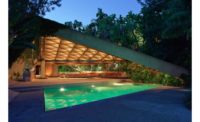It is difficult to pinpoint the most entrancing moment in Björk’s new retrospective at MoMA. Perhaps it is the vitrine containing a spookily realistic doll-sized version of the Icelandic songstress. Maybe it is the strident zap of a musical Tesla coil on view in the museum’s lobby. To some it was doubtlessly when Björk herself showed up dressed as a saguaro cactus to deliver a 70-second monologue to a sweaty press corps at Tuesday’s preview.
The exhibition may be one hell of a spectacle, but—to borrow from Mies—God is in the details. Overlooked by most preview-goers, architect David Benjamin and his Brooklyn-based firm The Living, owned by Autodesk, designed an immersive, albeit visually modest, acoustic space to set the stage for Black Lake, a specially-commissioned music video for the retrospective.
“It’s been an interesting challenge to design something that’s about an experience as much as it is about form and function—designing a feeling,” said Benjamin.
Black Lake, shot in Iceland by filmmaker Andrew Thomas Huang for Björk’s latest album, Vulnicura, is on view in a dark box-like room on MoMA’s second floor. When viewers enter this chamber, still blinking from the bright light of the atrium outside, the room appears unremarkable. As soon as the film begins, projected on two horizontal screens on either end of the room, however, the light reveals the surrounding walls, which are covered with hundreds of black, stalactite-like protrusions.
Like the visitors who entered the installation, Benjamin and his team at The Living began their project in the dark. When Benjamin was approached by the filmmaker to create the environment last year, the film wasn’t finished, and the song itself was still undergoing final edits. Nearly 40 different designs were proposed for the space, including versions made up of mycelium, a root fungus Benjamin developed to make bricks for his Hy-Fi pavilion at MoMA’s P.S.1 last year.
“We wanted the physical space to dampen the sound and we also wanted to create a texture that related to the landscape of the film,” explained Benjamin. “In the end, we used one of our early ideas which was to create a physical version of the song.”
Using software, the team created a spectral analysis of the song based on its decibel levels. The team mapped these diagrams onto the walls, letting the various frequencies determine the length of each barnacle-like felt cone, some as large as 18 inches, others as diminutive as three. Nearly 16,000 square feet of felt make up the protrusions, which are mounted to acoustically-treated walls. In fact, Benjamin says, each inch of the room’s surface corresponds to a single second of sound in the ten-minute song. “Someone on my team commented that it’s almost like a record player, because if you had the right needle you could play it,” Benjamin said.
The experience is a powerful one—and not just due to the 49 speakers meticulously installed by London-based sound designer, Immersive Audio. (Marco Perry, who mixed the sound, explained he had been making last-minute tweaks until 4 a.m. that morning). The walls seem to suck any superfluous sound out of the space, leaving the uneven cadence of the bass to thud in your chest cavity as the mournful lyrics of Black Lake unfold. Huang’s expert cinematography pairs beautifully with the textured walls, which, in turn, evoke the film’s alien, volcanic landscape.
“In a way, all architecture has a progression to it, but here it is very deliberate and choreographed, revealing the space over time.” says Benjamin. “It’s architecture for a single song.”
Björk opens to the public at the Museum of Modern Art March 8, and runs through June 7, 2015.
Watch the video trailer for Black Lake, below:












Post a comment to this article
Report Abusive Comment